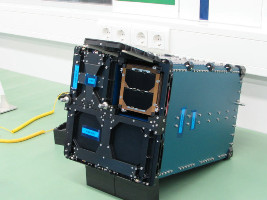| Spacecraft name | Al-Farabi-2 (Al–Farabi 2) |
|---|---|
| Spacecraft type | CubeSat |
| Units or mass | 1U |
| Status | Semi-operational? Was operational until 2021-XX-XX? (Last SatNOGS telemetry reports 2023-06-08 but short and scrambled packets. CW beacons seems always scrambled. Checked on 2023-06-10) |
| Launched | 2018-12-03 |
| NORAD ID | 43805 |
| Deployer | PSL / PSL-P (Picosatellite Launcher) [Astrofein],? |
| Launcher | Falcon 9 (Spaceflight SSO-A, SHERPA) |
| Organization | Al-Farabi Kazak National University |
| Institution | University |
| Entity | Academic / Education |
| Country | Kazakhstan |
| Launch brokerer | ISILaunch |
| Oneliner |
Educational mission with self-developed OBC and studying the effect of radiation on memory chips. |
| Description |
In addition to the main - educational mission, have a scientific, technological and real applied mission. The technological mission of the Al-Farabi-2 nanosatellite is to test in space the work of the on-board computer developed by the authors, as well as to test its own ground station and a number of software. The scientific mission is to study the effect of radiation on the memory cells of microcontrollers. In addition, Al-Farabi-2 has the function of greeting ground stations in more than 10 languages. |
| Sources | [1] [2] [3] [4] [5] [6] [7] |
| Photo sources | [1] |
| COTS subsystems |
|
| On the same launch |
|
Last modified: 2024-09-07




